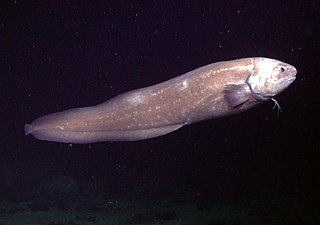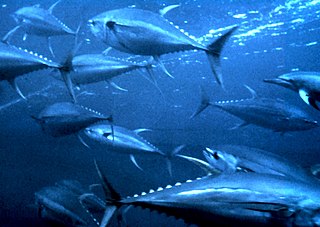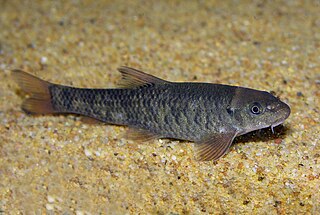
Salmonidae is a family of ray-finned fish, the only living family currently placed in the order Salmoniformes. It includes salmon, trout, chars, freshwater whitefishes, and graylings, which collectively are known as the salmonids. The Atlantic salmon and trout of the genus Salmo give the family and order their names.

Sturgeon is the common name for the 27 species of fish belonging to the family Acipenseridae. Their evolution dates back to the Triassic some 245 to 208 million years ago. The family is grouped into four genera: Acipenser, Huso, Scaphirhynchus and Pseudoscaphirhynchus. Four species may now be extinct. Two closely related species, Polyodon spathula and Psephurus gladius are of the same order, Acipenseriformes, but are in the family Polyodontidae and are not considered to be "true" sturgeons. Both sturgeons and paddlefish have been referred to as "primitive fishes" because their morphological characteristics have remained relatively unchanged since the earliest fossil record. Sturgeons are native to subtropical, temperate and sub-Arctic rivers, lakes and coastlines of Eurasia and North America.

Mahseer is the common name used for the genera Tor, Neolissochilus, and Naziritor in the family Cyprinidae (carps). The name is, however, more often restricted to members of the genus Tor. The range of these fish is from Malaysia, Indonesia, and across southern Asia including the Indian Peninsula and Pakistan. They are commercially important game fish, as well as highly esteemed food fish. Mahseer fetch high market price, and are potential candidate species for aquaculture. Several of the larger species have suffered severe declines, and are now considered threatened due to pollution, habitat loss, and overfishing.

"Sardine" and "pilchard" are common names used to refer to various small, oily fish in the herring family Clupeidae. The term "sardine" was first used in English during the early 15th century and may come from the Mediterranean island of Sardinia, around which sardines were once abundant.

The Lamniformes are an order of sharks commonly known as mackerel sharks. It includes some of the most familiar species of sharks, such as the great white and extinct megalodon, as well as more unusual representatives, such as the goblin shark and megamouth shark.

Arowanas are freshwater bony fish of the family Osteoglossidae, also known as bonytongues. In this family of fish, the head is bony and the elongated body is covered by large, heavy scales, with a mosaic pattern of canals. The dorsal and anal fins have soft rays and are long based, while the pectoral and ventral fins are small. The name "bonytongues" is derived from a toothed bone on the floor of the mouth, the "tongue", equipped with teeth that bite against teeth on the roof of the mouth. The arowana is a facultative air breather and can obtain oxygen from air by sucking it into its swim bladder, which is lined with capillaries like lung tissue.

Corydoras is a genus of freshwater catfish in the family Callichthyidae and subfamily Corydoradinae. The species usually have more restricted areas of endemism than other callichthyids, but the area of distribution of the entire genus almost equals the area of distribution of the family, except for Panama where Corydoras is not present. Corydoras species are distributed in South America where found east of the Andes to the Atlantic coast, from Trinidad to the Río de la Plata drainage in northern Argentina. Species assigned to Corydoras display a broad diversity of body shapes and coloration. Corydoras are small fish, ranging from 2.5 to 12 cm in SL., and are protected from predators by their body armor and by their sharp, typically venomous spines.

Rasbora is a genus of fish in the family Cyprinidae. They are native to freshwater habitats in South and Southeast Asia, as well as southeast China. A single species, R. gerlachi, is only known from an old specimen that reputedly originated from Africa (Cameroon), but this locality is considered doubtful. They are small, up to 17 cm (6.7 in) long, although most species do not surpass 10 cm (4 in) and many have a dark vertical stripe.

The Old World silversides are a family, Atherinidae, of fish in the order Atheriniformes. They occur worldwide in tropical and temperate waters. About two-thirds of the species are marine, and the remainder live in fresh water. The 74 species are in 13 genera. The genus Craterocephalus is the most diverse with 25 species. Four genera are monotypic.

The cusk-eel family, Ophidiidae, is a group of marine bony fishes in the order Ophidiiformes. The scientific name is from the Greek ophis meaning "snake", and refers to their eel-like appearance. True eels, however, diverged from other ray-finned fish during the Jurassic, while cusk-eels are part of the Percomorpha clade, along with tuna, perch, seahorses, and others. Unlike true eels of the order Anguilliformes, cusk-eels have ventral fins that are developed into a forked barbel-like organ below the mouth. In the true eels by contrast, the ventral fins are never well-developed and usually missing entirely.

The duckbill eels or witch eels are a family, Nettastomatidae, of eels. The name is from Greek netta meaning "duck" and stoma meaning "mouth".

Thunnus is a genus of ocean-dwelling, ray-finned bony fish from the Scombridae (mackerel) family. More specifically, Thunnus is one of five genera which make up the Thunnini tribe – a tribe that is collectively known as the tunas. Also called the true tunas or real tunas, Thunnus consists of eight species of tuna, divided into two subgenera. The word Thunnus is the Middle Latin form of the Ancient Greek: θύννος, translit. (thýnnos), lit. 'tunny-fish' – which is in turn derived from θύνω (thynō), "to rush; to dart". The first written use of the word was by Homer.

The Distichodontidae are a family of African freshwater fishes of the order Characiformes.

Garra is a genus of fish in the family Cyprinidae. These fish are one example of the "log suckers", sucker-mouthed barbs and other cyprinids commonly kept in aquaria to keep down algae. The doctor fish of Anatolia and the Middle East belongs in this genus. The majority of the more than 140 species of garras are native to Asia, but about one-fifth of the species are from Africa.

Zaniolepis is a genus of scorpaeniform fish native to the eastern Pacific Ocean. Z. frenata is known to have been a source of food to the Native American inhabitants of San Nicolas Island off the coast of southern California, United States during the Middle Holocene.

The Catostomidae are the suckers of the order Cypriniformes, with about 78 species in this family of freshwater fishes. The Catostomidae are primarily native to North America, but Catostomus catostomus is found in both North America and Russia, and Myxocyprinus asiaticus is from China. They are not usually fished recreationally; they are not highly prized in North America for their flesh, although they are a fairly popular target with spear fisherman, and in some areas, such as the Ozarks, they are a common food fish.

Valencia is the only genus in the family Valenciidae. Valencia is a genus of ray-finned fishes. It is sometimes grouped into the family Cyprinodontidae. Members of this genus are restricted to southern Europe.
Sundasalanx, the Sundaland noodlefishes, is the only genus in the family Sundasalangidae which belongs to the same order as the herrings and their relatives. This family of extremely small fishes is restricted to freshwater environments of Southeast Asia with Indonesia being home to the majority of species. The seven currently recognized species in this genus are:

Caesioperca is a genus of ray-finned fish in the sub-family Anthiadinae in the sea bass family Serranidae. It contains just two species, found in the ocean off Southern Australia and New Zealand.




















